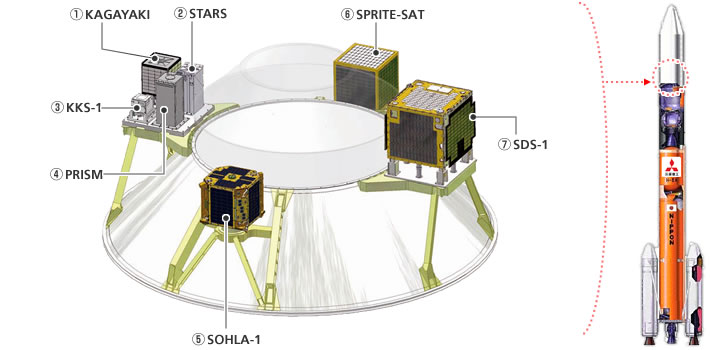IBUKI sat atop H-IIA off Tanegashima, Jan. 22, 2008
I have a feeling that Japanese space missions launches are left a bit orphaned on this forum...
So,
(I love the way the Japanese have everything accessible in one place)
http://www.jaxa.jp/countdown/f15/index_e.html
Scheduled date of launch :
January 23 (Friday,) 2009 (Japan Standard Time, JST)
Launch time :
Between 12:54 and 1:16 p.m. (JST)
.. 9:54 and 10:16 UTC
n order to promote preventive measures for global warming that are adopted by countries all over the world, it is imperative to learn the behavior of greenhouse gases that cause global warming on earth. The Greenhouse Gases Observing Satellite "IBUKI" (GOSAT) is a collaborative project by JAXA, the National Institute for Environmental Studies (NIES,) and the Ministry of the Environment (MOE) to provide the world's first satellite to observe global greenhouse gasses from space. Data acquired by the "IBUKI" will be utilized to learn the "current" status of the earth concerning global warming and to contribute to a better future for all mankind.
IBUKI promotional video link: mms://jda-str.tksc.jaxa.jp/jda/GOSAT_PR_e.wmv
IBUKI Injection Orbit
Sun-synchronous subrecurrent orbit at a perigee altitude of 667 km, apogee altitude of 683 km, and inclination of 98.0 degrees
The launch vehicle:
The H-IIA Launch Vehicle No. 15 is a "H2A202" model with two solid rocket boosters (SRBs). The fairing design is 4S (4 meters in diameter.) Mitsubishi Heavy Industries, Ltd. is in charge of the launch service of the H-IIA.
Piggyback payloads
Seven baby satellites, six small satellites selected through public tender and one JAXA small satellite, are scheduled to be launched by the H-IIA Launch Vehicle No. 15 with the "IBUKI."
"KAGAYAKI"
SORUN CORPORATION
The aim of the project is to connect the dreams of disabled children with space.
Small satellite "KAGAYAKI" official website
"STARS"
Kagawa University
This aims to conduct a tether space robot technology demonstration.
Kagawa satellite development project, STARS
"KKS-1"
Tokyo Metropolitan College of Industrial Technology
The goal is to perform a demonstration of the micro cluster and three axis attitude control functions.
KKS-1 project
"PRISM"
The University of Tokyo
This satellite will conduct an experiment on earth image acquisition by using an expandable refracting telescope.
The University of Tokyo ISSL PRISM Project Site
"SOHLA-1"
ASTRO TECHNOLOGY SOHLA
This will contribute to more vibrant activities for local industries.
It will measure thunder and lightening.
AstroTechnology SOHLA (Japanese only)
"SPRITE-SAT"
Tohoku University
The project will observe the sprite phenomenon and gamma radiation of the earth's origin.
Tohoku University SPRITE-SAT
Small Demonstration Satellite-1 (SDS-1)
Japan Aerospace Exploration Agency
This satellite has a multi-mode integrated transponder.
It will carry out on-orbit verification of the space wire demonstration module. On-orbit verification of a cutting-edge micro processor will also be performed.
http://www.jaxa.jp/pr/brochure/pdf/04/sat26.pdf










